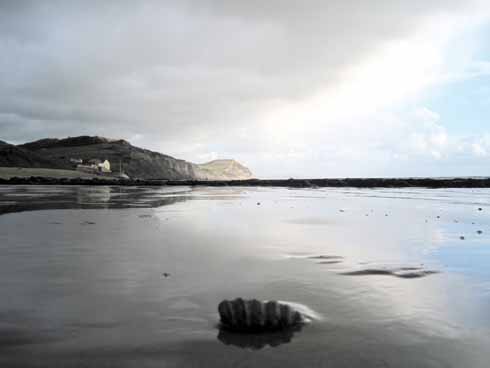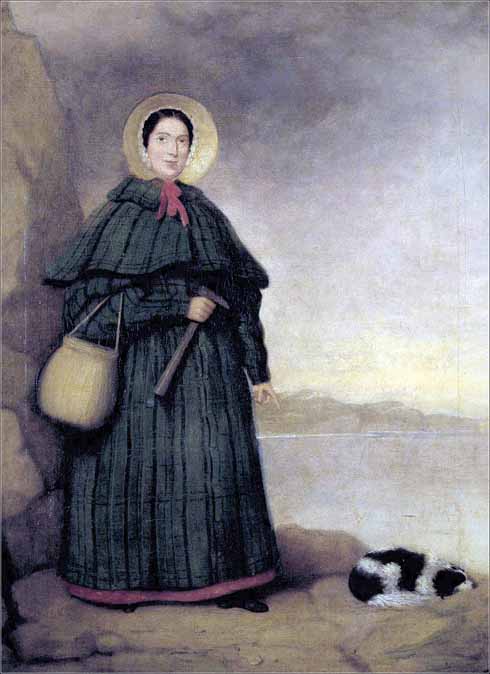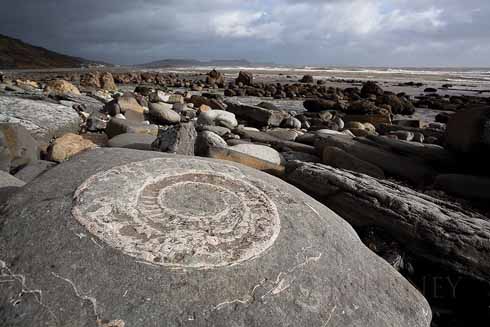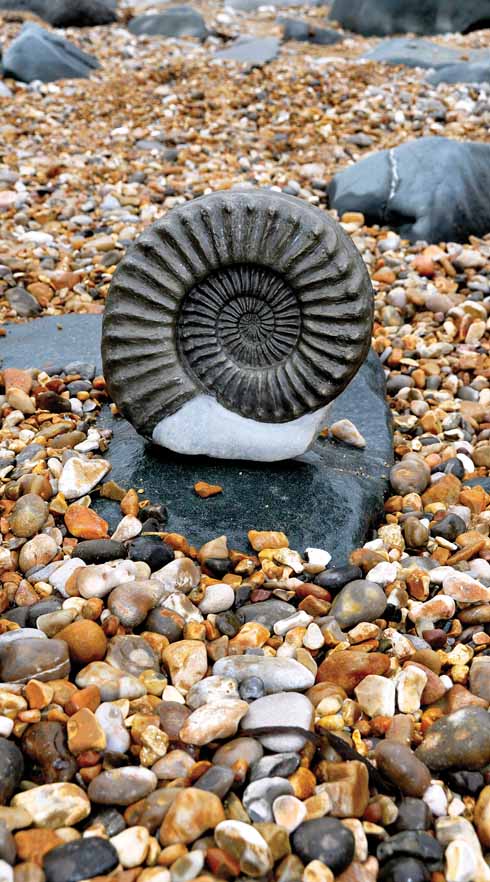From ancient to modern: Lyme Regis Fossil Festival
Nicci Brown looks at the Lyme Regis Fossil Festival, which mixes archaeology, art and music
Published in May ’12
The spirit of Mary Anning, Lyme Regis’s 19th-century pioneer palaeontologist, will take on a new significance with the town’s annual Fossil Festival, which this year launches the Jurassic Coast Earth Festival as part of Maritime Mix – London 2012 Cultural Olympiad by the Sea.
The local fossil hunter and collector, a poor cabinet-maker’s daughter, famously discovered the first ichthyosaur skeleton when she was just 12 years old, and her life-time’s work contributed to fundamental changes in scientific thinking about prehistoric life and the history of the earth – life which is visibly displayed in the Dorset and Devon Jurassic coastline, England’s only Natural UNESCO World Heritage Site.
For the past six years, the Fossil Festival has been at the forefront in fusing art and theatre with science to help people understand and appreciate the heritage on the doorstep and apply this local knowledge to live more sustainably. Fossils played a vital role in the gradual birth of the earth sciences, helping scientists hundreds of years ago to suggest and eventually prove theories such as continental drift, plate tectonics and evolution.
New finds are still being unearthed all the time along the Jurassic Coast, improving our understanding of ancient life. At the same time, studying the fossil record today helps palaeoclimatologists discover how life forms reacted to climate changes in the past so that we can begin to predict how the oceans might react to climate change today.
This year the Fossil Festival theme will be ‘Discovering Earth’ and Festival director Kimberly Clarke defined it by saying: ‘The format will be much the same as in previous years, with the huge free marquee on the beach containing displays from all our partners and exhibitors, many of whom are returning after successful earlier festivals. We’ll also have a programme of talks, fossil-hunting, walks on the beach, and poets, artists, musicians and actors helping to stimulate enquiring minds.’
However, the event is not merely a local one, as Kimberly explained: ‘The Natural History Museum will be sending dozens of scientists, and they will be in the Grand Marquee with lots of hands-on activities for the whole family. The British Antarctic Survey team is back this year too with fossils samples from the polar region and the kind of kit they use to keep warm in the field.’
As well as more established scientists, there is also public involvement. ‘We’ll have another particularly fun and exciting new activity this year too,’ explains Kimberly, ‘with a Bio-Geo Blitz run by the Buckland Club. Scientists and members of the public will work together to survey the Jurassic Coast. Data will be collected using Smartphones, then geo-tagged and uploaded into an online database and map, making the information accessible to everyone in a visually exciting way.
2012 also sees the launching of the Earth Festival – an umbrella name for a series of events and activities hosted by communities along Dorset’s (and Devons’s) coastline to celebrate its outstanding natural heritage. It is led by the Lyme Regis Development Trust, with UNESCO patronage, and is part of RELAYS, the Legacy Trust UK project for the southwest, supported by the Jurassic Coast World Heritage Site through Creative Coast. Building on the foundations laid by the Fossil Festival in furthering understanding, it aims to raise the profile of World Heritage Sites and highlight the values of UNESCO and the ethos of the Olympics while the world’s eye is on London and Weymouth & Portland in 2012.
The main Earth Festival focus will be from 4 May to the middle of June 2012, with a second phase from June to September, spanning the Olympics and Paralympics.
As part of the Fossil Festival launch, visitors will be able to experience Onboard – a low-carbon World Heritage Class virtual flight along the Dorset and East Devon coast created by communicator and model maker Richard Hartnell of Uplyme. The flight takes place in a pneumatically operated flight simulator, using new technology and a range of sensory effects to explore global environmental issues in relation to the passage of time. Mr Hartnell, who has worked in partnership with ICCI (Innovation for the Creative and Cultural Creative Industries), said: ‘The idea started to develop about a year ago, when I submitted drawings and proposals to Candida Baker, director of the Jurassic Coast Earth festival, which were then presented to the Arts Council and others. ‘A prototype was taken to the party conferences in the autumn in the search for funding, and there was a lot of interest.’
Next he had to plan the storyboard and gather together a number of people involved in the project. ‘A local school is helping with the website, and Weymouth College will hopefully participate in various ways. The University of Plymouth has specialist cameras with which to view the coast, and we are in partnership with Skyworks who shoot footage for the BBC.’
Onboard will launch at the Fossil Festival, and it will be screened throughout the summer at the Earth Festival, culminating in its use as an attraction at the 2012 Cultural Olympiad. ‘It is hoped the ‘flight’, which helps tell the story of the Jurassic coastline, can be used as an environmental teaching tool, and I want to make a legacy version of it,’ said Mr Hartnell. Also part of the Earth Festival launch at the Fossil Festival is ‘A Celebration of Time’ featuring singer-songwriter Robyn Hitchcock and performance-poet John Hegley. Both have long and honourable performance, recording and publishing histories and they share an ability to produce a compelling and communicative on-stage performance which is characterised by audience participation.
Their show at the Marine Theatre on 5 May is a mix of music, humour and philosophy based on the belief, as Robyn Hitchcock put it, that: ‘The Jurassic Coast is a portal to eternity, where the strata of fossilised time intersects with the ocean, the mother and eraser of all’.
Visitors to the festivals will also be able to play their part in the creation of an ongoing stone memorial to extinct species being built by MEMO, the Mass Extinction Memorial Observatory. The project, led by Sebastian Brooke, is an educational charity dedicated to making a monument bearing the images of all the species of plants and animals known to have become extinct in modern times.
MEMO is supported by the UN, and key partners include the Royal Society, board chair and former director of Kew Gardens Sir Ghillean Prance, and principal advisor Eden Project director Tim Smit. Secondary school children have been helping to carve patterns based on the forms of micro-organisms, and people will be invited to join the MEMO team carving another endangered species to form part of the memorial.
Pliosaur is an Earth Festival flagship project devised by visual theatre-maker Sarah Butterworth with theatrical engineer Mike Pattison, actor Peter Courtenay and film by Forkbeard Fantasy. They have worked closely with earth scientist Dr Leslie Noe, and with artistic input also from Hazel Hurn and students at Arts University College Bournemouth as well as technical expertise from Nigel Day and director Holly Stoppit. Inspired by the 2.4 metre fossilised skull found in Weymouth Bay in 2009 and now housed in Dorset County Museum, Pliosaur is a giant, interactive and cinematic puppet created to celebrate the groundbreaking local find. ‘We don’t have any photos yet as the beast is not yet built, and we want it to be a surprise,’ said Sarah. ‘But progress can be followed on Facebook at Pliosaur Sea Lizard, where people can befriend it. It’s being made in my workshop and going to measure 35 foot x 25 foot x 10 foot high, about the same size as the Weymouth Bay Pliosaur would have been. The travelling cinema with performing professors will be particularly appealing to children, who will be able to operate parts of its head, jaw and eyes, and climb inside the belly to experience a special type of Jurassic animated cinema and puppetry.’
Another Earth Festival attraction making a renewed appearance is Jurassic Journey, an exhibition of photographs by wildlife photographer Ben Osborne enhanced by an artist-led collaboration with poet Matt Harvey, musician Sammy Hurden and visual artist Lal Hitchcock. Osborne, the highly acclaimed Wildlife Photographer of the Year 2007 and a stills photographer for David Attenborough’s BBC series, recorded a visual diary of his experiences of the Jurassic Coast to provide raw material for the touring show and exhibition. With input from scientists and geologists, it blends photography, digital imagery, music, poetry and sculpture made from flotsam and jetsam to celebrate the World Heritage site.
Commissioned by Artsreach and Villages in Action in association with a range of arts and local authority sponsors, the show has already toured village halls around the country, but the festival launch will be an opportunity to take a more relaxed view of the material which will continue touring in the summer of 2012. Following the Lyme Regis launch, there will be a number of arts and science projects associated with the Earth Festival at events including annual festivals in Exmouth, at Bridport Arts Centre, and at National Trust properties and museums.
For more information on all the events making up the Earth Festival, visit www.earthfestival2012.org







